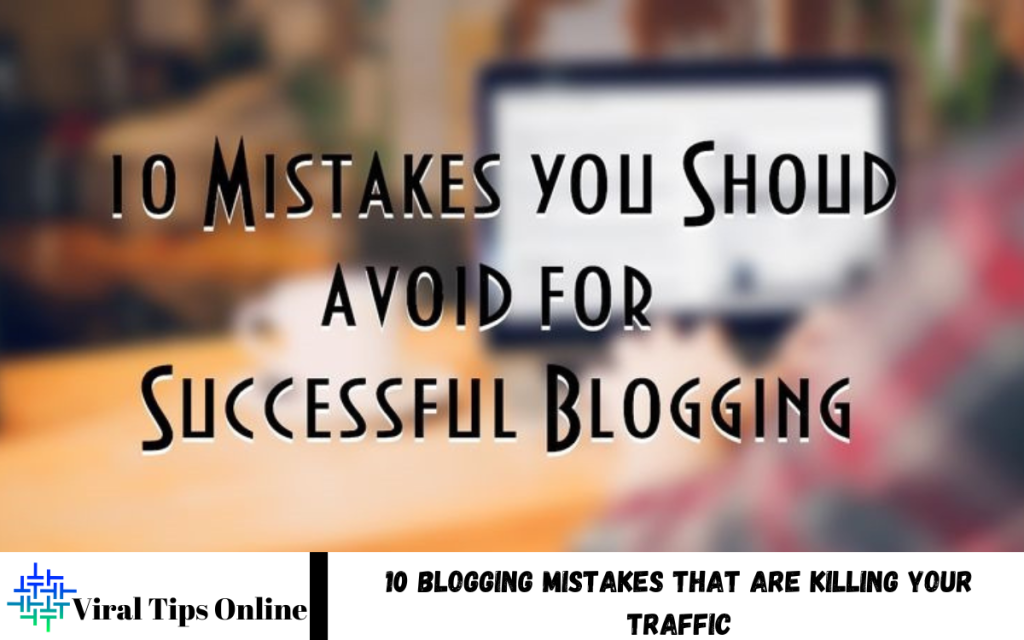Blogging is one of the most effective ways to grow your online presence, attract loyal readers, and boost business visibility. However, many bloggers unknowingly make common mistakes that prevent their content from reaching its full potential. Whether you’re a beginner or an experienced writer, these errors can silently kill your traffic, reduce engagement, and harm your search rankings.
From neglecting SEO fundamentals to ignoring audience needs or inconsistent posting schedules, each mistake can have a lasting impact on your blog’s success. Understanding what you’re doing wrong is the first step toward improvement. In this article, we’ll uncover the 10 blogging mistakes that are killing your traffic and explain how to fix them effectively.
Ignoring SEO Fundamentals
Search Engine Optimization (SEO) is the foundation of blogging success. Many bloggers focus only on writing but ignore SEO basics such as keyword research, meta descriptions, and internal linking. Without optimization, even valuable content remains invisible to search engines.
How to Fix It:
- Use keyword tools like Ahrefs, Ubersuggest, or Google Keyword Planner.
- Optimize your headings (H1, H2, H3) with relevant keywords.
- Write engaging meta titles and descriptions.
- Include internal and external links naturally.
Mastering these SEO basics can increase visibility and organic traffic significantly.
Writing Without Understanding the Audience
A common blogging mistake is creating content without knowing who you’re writing for. Without a clear audience, your blog posts might lack focus and fail to solve real problems.
How to Fix It:
- Define your target reader their age, interests, and pain points.
- Study analytics to understand which posts perform best.
- Use reader feedback to improve your topics.
When you write with your audience in mind, engagement and retention increase automatically.
Inconsistent Posting Schedule
Search engines and readers both value consistency. Irregular posting confuses your audience and hurts your ranking potential. Many bloggers publish multiple posts in a week, then disappear for months — a fatal mistake for growth.
How to Fix It:
- Create a content calendar and plan posts weekly or biweekly.
- Stick to a schedule you can realistically maintain.
- Repurpose content to maintain frequency (e.g., turn blogs into short videos or infographics).
Consistency signals reliability, helping your blog gain trust and steady traffic.
Neglecting Mobile Optimization
More than 60% of internet users browse on mobile devices. If your blog isn’t mobile-friendly, visitors leave quickly increasing bounce rates and lowering rankings.
How to Fix It:
- Use a responsive WordPress theme or website builder.
- Test your site’s mobile performance using Google Mobile-Friendly Test.
- Compress images and use faster hosting to reduce loading time.
A smooth mobile experience ensures that every visitor can easily read and navigate your content.
Poor Content Quality
Even the best SEO strategies can’t save low-quality content. Writing shallow, repetitive, or poorly researched posts drives readers away. High-quality, original, and helpful articles build authority and attract backlinks naturally.
How to Fix It:
- Conduct thorough research before writing.
- Use clear formatting with short paragraphs and bullet points.
- Add images, charts, and infographics for better understanding.
- Provide actionable takeaways at the end of every post.
Quality always wins in the long run both for readers and search engines.
Not Promoting Your Blog
Publishing a great article isn’t enough you need to promote it effectively. Many bloggers rely solely on organic search traffic, but that’s a mistake. Without promotion, your content remains hidden.
How to Fix It:
- Share posts on social media platforms like Facebook, LinkedIn, X (Twitter), and Pinterest.
- Join blogging communities and forums to share knowledge.
- Build an email list to send updates directly to your audience.
- Collaborate with influencers and guest post on related blogs.
Promotion amplifies your reach and brings in consistent visitors.
Ignoring Analytics and Data
If you’re not tracking your blog’s performance, you’re essentially guessing. Ignoring analytics prevents you from understanding what works and what doesn’t.
How to Fix It:
- Install Google Analytics and Google Search Console.
- Monitor metrics like bounce rate, average session duration, and traffic sources.
- Identify which topics and keywords drive the most engagement.
Data-driven blogging helps refine your strategy and ensures continuous improvement.
Forgetting About User Experience (UX)
Even if your content is great, poor design or slow loading speed can ruin the user experience. Visitors expect clean layouts, fast loading, and easy navigation.
How to Fix It:
- Keep your website design simple and clutter-free.
- Optimize images and plugins to improve loading speed.
- Use readable fonts, clear CTAs (Call-to-Action), and structured headings.
Great user experience not only improves traffic but also boosts conversions.
Skipping Email Marketing
Many bloggers underestimate the power of building an email list. Relying solely on social media or search engines for traffic is risky algorithms change frequently. Email marketing creates a loyal audience that keeps returning.
How to Fix It:
- Offer free resources (ebooks, checklists, templates) to attract subscribers.
- Send regular newsletters with valuable insights.
- Personalize emails for better engagement.
A strong email list guarantees stable, long-term blog traffic.
Read Also: How to Choose Safe Apps – Avoiding Scams & Malware
Giving Up Too Early
Blogging success doesn’t happen overnight. Many quit after a few months when they don’t see immediate results. However, traffic growth takes time especially when building from scratch.
How to Fix It:
- Set realistic goals for 6–12 months.
- Keep improving your content strategy.
- Network with other bloggers for guidance and collaboration.
Persistence separates successful bloggers from those who give up too soon. Every post you publish strengthens your foundation.
Bonus Tips to Grow Blog Traffic in 2025
- Update old posts — Refresh outdated articles to maintain rankings.
- Focus on long-tail keywords — They attract targeted visitors with higher conversion potential.
- Add videos or podcasts — Multimedia content improves engagement.
- Leverage AI tools — Use AI writing assistants to brainstorm ideas and speed up research.
- Optimize for voice search — Write conversationally to capture growing voice queries.
By applying these modern strategies, you’ll keep your blog relevant and competitive in the evolving digital space.
Frequently Asked Questions
What tools can help improve my blog’s SEO?
Popular SEO tools include Yoast SEO, Ahrefs, SEMrush, Ubersuggest, and Google Search Console. These help with keyword research, tracking performance, and optimizing blog structure.
How can I promote my blog effectively?
Promote your blog through social media platforms, email newsletters, guest posting, and collaborations. Share posts in relevant online communities and engage with readers regularly.
Why is mobile optimization critical for blogging?
More than half of all web traffic comes from mobile devices. A mobile-friendly blog ensures faster loading, better readability, and higher user satisfaction, which improves rankings.
How do I know if my blog content is performing well?
Use analytics tools like Google Analytics to track page views, bounce rate, and session duration. Identify high-performing posts and replicate their structure or topics to drive more traffic.
Can I still grow a new blog in 2025?
Yes, absolutely. With the right SEO strategy, consistent posting, and valuable content, new blogs can still gain massive traffic in 2025. Focus on niche topics and build authority gradually.
How long does it take to see traffic growth on a blog?
Typically, it takes 3–6 months to see noticeable growth, depending on niche competition and effort. Patience, consistency, and smart optimization are key to long-term results.
Conclusion
Blogging success depends on strategy, consistency, and adaptability. The 10 blogging mistakes that are killing your traffic often go unnoticed but have massive effects on your growth. From ignoring SEO to skipping promotion, each mistake creates an obstacle between your blog and your audience.
Avoiding these errors and following the right strategies can turn your blog into a reliable traffic-generating asset. Focus on quality, understand your audience, optimize your site, and never stop learning. Blogging is a long-term journey and every improvement brings you closer to success.


